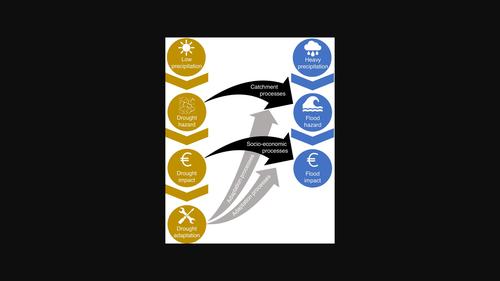Exploring drought-to-flood interactions and dynamics: A global case review
引用次数: 0
Abstract
This study synthesizes the current understanding of the hydrological, impact, and adaptation processes underlying drought-to-flood events (i.e., consecutive drought and flood events), and how they interact. Based on an analysis of literature and a global assessment of historic cases, we show how drought can affect flood risk and assess under which circumstances drought-to-flood interactions can lead to increased or decreased risk. We make a distinction between hydrological, socio-economic and adaptation processes. Hydrological processes include storage and runoff processes, which both seem to mostly play a role when the drought is a multiyear event and when the flood occurs during the drought. However, which process is dominant when and where, and how this is influenced by human intervention needs further research. Processes related to socio-economic impacts have been studied less than hydrological processes, but in general, changes in vulnerability seem to play an important role in increasing or decreasing drought-to-flood impacts. Additionally, there is evidence of increased water quality problems due to drought-to-flood events, when compared to drought or flood events by themselves. Adaptation affects both hydrological (e.g., through groundwater extraction) or socio-economic (e.g., influencing vulnerability) processes. There are many examples of adaptation, but there is limited evidence of when and where certain processes occur and why. Overall, research on drought-to-flood events is scarce. To increase our understanding of drought-to-flood events we need more comprehensive studies on the underlying hydrological, socio-economic, and adaptation processes and their interactions, as well as the circumstances that lead to the dominance of certain processes.

探索干旱与洪水的相互作用和动态:全球案例回顾
本研究综述了目前对干旱到洪水事件(即连续干旱和洪水事件)背后的水文、影响和适应过程以及它们如何相互作用的理解。基于对文献的分析和对历史案例的全球评估,我们展示了干旱如何影响洪水风险,并评估了在哪些情况下干旱与洪水的相互作用会导致风险的增加或减少。我们区分了水文过程、社会经济过程和适应过程。水文过程包括蓄水过程和径流过程,当干旱是多年事件和洪水发生在干旱期间时,这两种过程似乎都会发挥主要作用。然而,哪种过程在何时何地起主导作用,以及人类干预对其有何影响,还需要进一步研究。与水文过程相比,与社会经济影响相关的过程研究较少,但总体而言,脆弱性的变化似乎在增加或减少旱涝影响方面发挥着重要作用。此外,有证据表明,与干旱或洪水事件本身相比,干旱转化为洪水事件会导致水质问题加剧。适应既影响水文过程(如通过抽取地下水),也影响社会经济过程(如影响脆弱性)。适应的例子很多,但关于某些过程发生的时间和地点以及原因的证据却很有限。总体而言,有关旱涝灾害的研究很少。为了加深我们对旱涝灾害事件的了解,我们需要对基本的水文、社会经济和适应过程及其相互作用以及导致某些过程占主导地位的情况进行更全面的研究。
本文章由计算机程序翻译,如有差异,请以英文原文为准。
求助全文
约1分钟内获得全文
求助全文

 求助内容:
求助内容: 应助结果提醒方式:
应助结果提醒方式:


